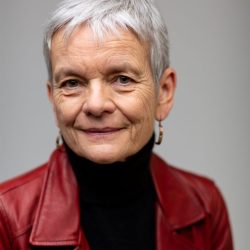
I’ve been thinking — and worrying — about climate change for a long time. In 1980, I came to the University of Washington to pursue a PhD, wrestling with the problem of detecting the fingerprint of human impact on the climate system. The topic held sway with my colleagues but had no traction with the general public.
All that has changed, and that change is now visible in many ways across the globe.
Last month, I walked into the 27th UN Climate Conference (commonly known as COP27) in Sharm el Sheikh, Egypt and joined over 35,000 people from around the world for whom climate change was front and center on their mind. It was a diverse crowd. The first thing you’d notice as you join the crowded queue to enter COP27 is that you are hearing at least half a dozen languages being spoken. You are surrounded by people in business suits, caftans, saris, ghutras, and blue jeans. There is a buzz in the air as people enter with high hopes for progress on climate change.
I attended the COP as a delegate in my role as President-Elect of the American Geophysical Union (AGU) with a specific purpose: to bring forward the AGU-led effort to develop an ethical framework to guide research and deployment of climate intervention initiatives. Yet I also found time to explore the sprawling convention center, which gave me tremendous new insights and perspective.
There’s a lot more to COP than what we see in the media. Yes, there were a dozen large, formal meeting rooms where negotiations took place among the countries of the world. I estimate that there were thousands of people there to support the delegates. The deliberations were — what can I say — deliberate. Consensus among all nations is hard won. The political divide between rich and poor countries is stark. Progress in key areas of mitigation and adaptation is glacial. As the week began, the conversation on funding for loss and damage started and mostly stopped. It was easy to lose hope.
But when I ventured beyond the formal deliberation rooms, I came to the pavilions — a maze of pop-up structures jammed together in a hugely sprawling complex. Tens of thousands of people gathered in the pavilions day after day. It was noisy and vibrant, teeming with people who were deep in the work of climate change mitigation and adaptation — not deliberating, but rolling up their sleeves to get it done now.
The pavilions had different vibes. The Intergovernmental Panel on Climate Change (IPCC) pavilion was centrally located with floor-to-ceiling glass walls. As many will recall, the IPCC is commissioned by the UN to do regular assessments of the scientific basis of climate change, its impacts and future risks, and options for adaptation and mitigation. I loved walking by the IPCC pavilion, watching as scientists gave science briefings. These were moments of pride. This was our scientific community who has been collaborating and carefully preparing assessments and briefings and executive summaries and press releases and more assessments and more briefings and so on and so on, for decades. This is the scientific foundation on which the entire COP process rests.

Venturing deeper into the warren of pavilions, I found the civil society pavilions — the Resilience Hub, the Just Transition Hub, the Brazilian Climate Action Pavilion, and so many more — interspersed with funders, ranging from the Bloomberg Philanthropies to the Islamic Development Bank. Unlike the calm and measured PowerPoint presentations at IPCC, there were scenes of highly interactive panels with a range of scholars and practitioners, vigorous hallway discussions, and peaceful protests and demonstrations. A favorite stop for me was the Children and Youth Pavilion, where young leaders spoke with insight and conviction about the stakes for their generation and ended the day with raucous dance parties.
Some of my most powerful experiences came when I got lost, which was easy to do. I found myself in conversations with people on the front lines of climate change. These connections yielded new insights and new friendships, and as a result, adaptation and coping with loss and damage are much more real to me.
In the moment, the experience of attending a COP is information overload. I’ve now had time to reflect, and on returning home I have been repeatedly asked what I thought of COP27. Yes, the world of the official deliberations can seem hopelessly bogged down while the goal of keeping global warming to 1.5C fades in the face of growing emissions. At the very same time, I am buoyed by the energy, ingenuity, and commitment I saw in the world of the pavilions, an energy that is being channeled into advancing climate action now. Hundreds of millions of dollars are being mobilized for the purpose of capacity building to develop country-level adaptation policies and implementation strategies that connect locally led initiatives with international financing opportunities. There are innovative frameworks, like the Bridgetown Initiative championed by Prime Minister Mia Mottley of Barbados, that could mobilize a trillion dollars in private capital to invest in the Global South — at the scale and in the time frame to make a real difference. And there’s the foundation of science that underpins and informs everything.
What does this all mean for our research community? Importantly, our work as authors of IPCC-cited science papers is not done yet. We must continue to deliver information that accelerates our understanding of the climate system and how it is changing. This is vital for decision-making and action. And there’s even more to do! We must mobilize the best available science with an eye towards local context and people’s lived experience to develop adaptation strategies that increase resilience and decrease vulnerability to climate change. We must double down on our support for nature-based solutions to buffer the effects of greenhouse gas emissions in a way that keeps nature healthy and thriving. And we must engage our students, not only in understanding the physical drivers of a changing climate, but also the levers we can utilize as humans embedded within our own social constructs to head off a disastrous future.
As for individuals, researcher or not, it means we should find hope that we can curb our appetite for fossil fuels and set ourselves on a better course. This hope should not, cannot, be blind; it must be active. We should make our voices heard and participate in the processes that feed into larger efforts like the COP, and utilize their function to organize us globally to focus our own approach at home. And then act.
As I step into my role as President of AGU, the experience of COP27 sticks with me and helps shape my perspective. I can’t help but be daunted at the task ahead in this all-hands-on-deck moment; but that is outweighed by the hope and action I am seeing taking shape in our community and beyond to take climate change seriously, deliver resources to confront it, and set ourselves on a global course for a better and prosperous future. I hold this hope at my very core.
Lisa Graumlich is the Denman Endowed Professor in Sustainable Resource Sciences in the School of Environmental and Forest Sciences, Dean Emeritus of the UW College of the Environment and President-Elect of the American Geophysical Union. She recently attended the UN Climate Change Conference in Egypt and shares her reflections.

